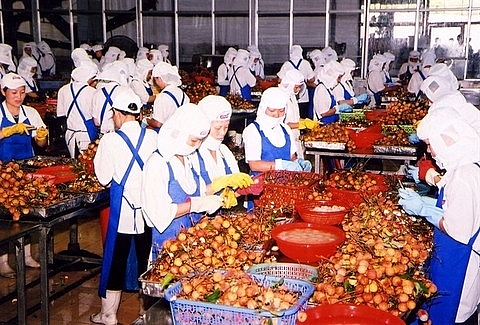Fruit exports chief concern for provinces
 |
| Litchi process chain at Dong Giao Foodstuff Export Joint Stock Company (Doveco)’s factory in Ninh Binh City. - VNA/VNS Photo Dinh Hue |
The proposal was the key topic of discussion at on Wednesday’s annual conference in Ha Noi on the production and distribution of these two main fruit products in northern areas.
Per the request, the Minister of Agriculture and Rural Development (MARD), Ministry of Industry and Trade and Ministry of Foreign Affairs will arrange talks with their Chinese counterparts to promote Vietnamese fruits’ entrance into the country, via negotiation, plant quarantine agreements and removing technical barriers.
Minister of Agriculture and Rural Development Nguyen Xuan Cuong expressed determination to help the provinces sell their products at home and abroad.
Nguyen Hong Son, head of MARD’s Crop Production Department, said domestic litchi and longan consumption accounts for about 50 per cent of output, albeit this number is on the rise, mainly in urban areas.
Therefore, it is necessary to focus on these markets, by connecting producers with chain distributors and wholesale markets, while keeping current importers satisfied, such as China, the US, Japan and Australia.
He said that Vietnamese agricultural products are still accepted in China with little obstacles regarding regulations on origin and plant quarantine.
Hoang Trung, Director General of the MARD’s Plant Protection Department (PPD), said this year, his unit will conduct its first on-site tests for litchi and longan crops during the harvest season in the provinces.
The PPD will arrange mobile quarantine rooms in concentrated areas to issue certificates on the spot for exporting enterprises, instead of doing so at the border. This will help reduce congestion and shorten clearance time at the border, said Trung.
The PPD has also been negotiating for higher fruit exports quota to Japan and South Korea, as many Japanese and Korean companies are keen on importing these fruits.
Meanwhile, Nguyen Thi Thu Ha, Vice Chairwoman of Bac Giang Provincial People’s Committee, said her constituency considers litchi the key driver for economic development.
As current local production accounts for nearly 29,000 hectares, 2018’s output is estimated at 150,000 to 180,000 tonnes, nearly double last year’s number, said Ha.
Such abundant yields, coupled with short harvesting time, storage and transportation difficulties, have pressured the province to find an appropriate consumption market.
At present, the Chinese province of Guangxi has requested proof of traceability for Viet Nam’s agricultural products, which means the province must negotiate with Chinese partners to resolve any remaining difficulties.
On the same note, Tran Cong Truong, Vice Chairman Lang Son Provincial People’s Committee, said China had asked his province to impose tighter controls on agricultural goods entering China via Lang Son border gate.
Starting May 1 this year, farmers will be required to provide proper packaging and product labels in order to export to China.
To meet the requirements of traditional export markets and to expand to new markets for fruit and nuts, Viẹt Nam needs to improve its activities in terms of quality, design and food safety.
Dinh Cao Khue, General Director of the Dong Giao Foodstuff Export Joint Stock Company, said that his company has about 5,000 tonnes of processed litchi ready for export, with prospects for fresh exports as well.
Khue was confident that Vietnamese products are strong enough to compete with other countries’, though they still need promotions abroad.
Litchi and longan are the two main fruit-bearing crops in northern provinces, with a total area of 98,000 hectares, accounting for 27 per cent of total agricultural harvest, whose accumulated output is estimated to exceed 217,000 tonnes in 2018.
What the stars mean:
★ Poor ★ ★ Promising ★★★ Good ★★★★ Very good ★★★★★ Exceptional
Related Contents
Latest News
More News
- Double-digit GDP growth within reach with shift to higher-value expansion (January 06, 2026 | 08:33)
- Takeda Vietnam awarded for ongoing support of Vietnam’s sustainability efforts (December 31, 2025 | 21:00)
- Vietnam's retail market tops $269 billion in 2025 amid e-commerce boom (December 31, 2025 | 19:00)
- Stronger legal framework urged as trade fraud surges online (December 31, 2025 | 18:58)
- FPT exports first chip shipment to Japan (December 31, 2025 | 10:47)
- AkzoNobel rolls out sustainability campaign “It All Adds Up” for the wood sector (December 31, 2025 | 09:23)
- Textile apparel firms deliver robust earnings despite global tariff pressures (December 30, 2025 | 10:09)
- Businesses ramp up production as year-end orders surge (December 30, 2025 | 10:05)
- Vietjet chairwoman awarded Labour Hero title (December 29, 2025 | 13:06)
- How to unlock ESG value through green innovation (December 29, 2025 | 10:03)

 Tag:
Tag:



















 Mobile Version
Mobile Version